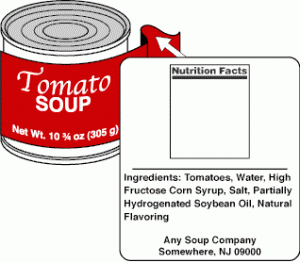How to read food labels: Part 2
Posted on | September 7, 2010 | No Comments
Once you’ve mastered reading the nutrition panel now it’s time to move on to the ingredients list which can also tell you alot about the product itself.
Some things you may not know:
All ingredients must be listed in decreasing order by weight, including added water. Therefore:
First ingredient = Largest amount
Last ingredient = Least amount
Step 1: Read the ingredients in the picture below and refer to it for all the other parts of this: You can see from reading it that it’s saying that tomatoes are the largest ingredient used in the product and natural flavour is used in the smallest quantity.

Ingredients list
Why is this important? Always get scared if the ingredient listed first is sugar. And – anything ending in ‘ose’ is a sugar – i.e. sucrose, fructose, maltose, lactose. Therefore, you’ll notice that ‘high fructose corn syrup’ has been used in this tomato soup = sugar!
Note: Where there are very small amounts of multi-component ingredients (less than 5%), it is permitted to list ‘composite’ ingredients. Eg: It’s allowable to say ‘chocolate chips’ rather than list out milk, sugar, cocoa (because they are in such small quantities). And if an ingredient is less than 5% of the food product itself, it does not have to be listed at all!!
Watch out for the scary ingredients
Watch out for the nasty ingredients that can impact your health. Avoid (or keep to a minimum) food that contains “partially hydrogenated oils” or “hydrogenated vegetable oil” as it’s the ‘nice’ way of saying TRANS FATS! Eating trans fats can increase your bad cholesterol, lower your good cholesterol and increase insulin resistance by the body. (Did you think ‘Partially hydrogenated soybean oil” sounded bad when you first read it in the ingredients list??)
Food names can’t lie! If product is called: White Fish and Herb Risotto – its must contain those ingredients!!
Food Additives: Food additives must be assessed, approved for use & used in smallest possible quantity in food products. They are listed in class & given a number – generally with an E in front. The same food additive numbering system is used through the world.
Sometimes food additives can increase the nutritional profile of foods such as Vitamins and minerals (They have E-numbers too) – but more often than not – food additives are bad for your health and can produce severe health complications. Here are some of the nasty ones to avoid:
E951 – Sweetener (Aspartame – linked to causing brain cancer)
E950 – Sweetener (Acesulfame Potassium – linked to Neurodegeneration of the brain)
E310 – Propyl Gallate (Synthetic Antioxidant / Preservative – linked to causing cancer)
E320 and 321 – Butylated hydroxyanisole (BHA) and butylated hydrozyttoluene (BHT) – (Synthetic Antioxidant / Preservative – linked to causing cancer)
E210 – Preservative (Benzoic Acid – Synthetic Preservative – carcinogenic)
E211 – Preservative (Sodium Benzoate – Synthetic Preservative – carcinogenic)
E621 – MSG (Monosodium glutamate – Flavour enhancer that can cause headaches, nausea, swelling, breathing difficulties and rashes.
Artificial Food Colourings – Linked to many health problems
If you head to your cupboard now and start reading your pre-packaged foods (even the ‘healthy’ stuff) – you’ll notice that most processed food contains lots of sugar, preservatives and artificial colours & flavours. This is to extend the shelf life of products, to enable them to keep their shape, to improve the taste and look so people buy them and make it easy to mass produce. Unfortunately, these are creating lots of health problems – health problems that people keep happily munching down without realising.
So, do some research – find out exactly what you’re putting in to your body and start to make better choices.
Always choose products that have all natural colours and flavours, No MSG, No Trans fats, No preservatives, Low Sugar, Low Fat – And when in doubt – Fresh is best as you can make it yourself with the guarantee that you know exactly what you’re putting in your food.
Related posts:
Artificial trans fats are (or hydrogenated fat...
With the endless pre-packaged food options these d...
There are many different nam...
Tags: How to read food labels > how to read food panels > MSG > trans fats
Comments
Leave a Reply
You must be logged in to post a comment.




